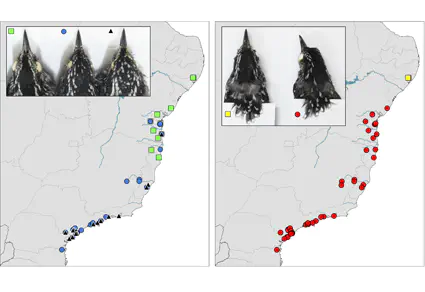Taxonomic revision of the Scaled Antbird Drymophila squamata (Aves: Thamnophilidae) reveals a new and critically endangered taxon from northeastern Brazil
 Plumage variation in Drymophila squamata. (A) Unstructured variation in crown pattern. (B) Geographically segregated markings of the back.
Plumage variation in Drymophila squamata. (A) Unstructured variation in crown pattern. (B) Geographically segregated markings of the back.Abstract
The Scaled Antbird Drymophila squamata is a suboscine passerine endemic to the Atlantic Forest of eastern Brazil. Two subspecies, putatively diagnosed by the presence/absence of white spots on the crown, have traditionally been recognized: the nominate, ranging from Pernambuco to Bahia in northeastern Brazil, and D. squamata stictocorypha, from Minas Gerais to Santa Catarina in southeastern and southern Brazil. Here we combine morphological, acoustic, and genetic data to examine geographic variation in and revise the taxonomy of D. squamata. We show that there are two separately evolving population lineages in D. squamata, one south and the other north of the São Francisco River. The latter is unnamed and is thus described herein. We found that crown variation is not as geographically structured as previously thought, and thus we suggest that D. squamata stictocorypha is not a valid taxon. Finally, we also provide evidence of clinal variation in the species’ vocalizations and underscore the importance of broad geographic sampling when assessing species limits using vocalizations.